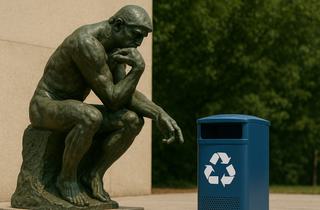Nudging towards greener habits: using behavioural science in your workplace waste program
July 17, 2025
Recycle stations look simple: blue for containers, black for landfill, green for organics. Yet roughly one‑quarter of what North‑American offices place in the blue bin is too contaminated to recover (Illinois State University, 2019). Those errors drive surcharge costs, undercut your ESG metrics and affect employees’ confidence in the program.
Behavioural science points to a solution. By redesigning context rather than lecturing people, we can make the sustainable choice feel like the obvious one. Below are four field‑tested levers and a practical rollout plan.

1. Ease: remove friction, boost diversion
Convenience routinely beats conscience. When the University of British Columbia moved recycling and compost bins from the end of the hallway to within 1.5 metres of residence‑hall doors, diversion jumped 141 % (UBC study). Offices report similar gains when the landfill bin is placed furthest from reach.
Cornell University’s “mini‑bin” pilot program replaced full‑size desk trash cans with palm‑sized cups clipped to a recycling basket; landfill volume halved in three months while correct recycling climbed 22 % (Cornell pilot).
Takeaway: Group all waste streams at a single station, shrink the landfill bin, and place stations where staff already pause (for example at printers, elevators or kitchenettes).
2. Feedback: Show the score so people can beat it
Sorting can feel like dropping material into a black hole. In a university field test, an “eco‑feedback” bin with lights and a running counter boosted recycling among passers‑by (Mozo‑Reyes et al., 2016).
You don’t need electronics to copy the effect:
- Post a weekly Waste Wednesday snapshot in Slack using weight totals from your hauler’s invoice.
- Stick a friendly “Oops” tag on any contaminated bin and note the date; improvement shows quickly.
- Shout out the most‑improved floor at the monthly town hall.
Visible feedback turns waste sorting from a backstage activity into a public scoreboard and spurs teams to beat their own best.
3. Norms: harness healthy peer pressure
We take behavioural cues from peers. In two Swedish municipalities, quarterly letters comparing each household’s residual‑waste weight to the neighbourhood average cut unsorted waste by 7–12 % (Ratio field experiments).
At the office, a simple poster by the elevator that reads “Last week we sorted 83 % of our waste correctly” triggers the same effect. A friendly mention in the weekly all‑hands email for the department that improved the most keeps the competition going and nudges late adopters.
4. Point‑of‑decision prompts: intercept the toss
Even with good signage and peer pressure, mistakes happen when employees stand above the bins. A cue that appears right at that moment can tip the decision:
- Shape cues – a slot for paper, a round hole for bottles, a small rectangle for food trays.
- Colour “runways” – floor arrows or footprints painted in the stream colour guiding items to the right opening.
- Micro‑labels – short yes‑or‑no questions on the lid (“Is it mostly liquid?” “Is it CLEAN cardboard?”).
- QR cheatsheets – a quick scan opens a 10‑second visual guide for tricky items.
Because these prompts appear at the exact point of decision, they rescue materials that training sessions and posters can miss.
A quick aside on plastics
Changing the default is one of the strongest behavioural levers. A Chinese food‑delivery platform switched the default to “no cutlery,” prompting orders without utensils to jump 648 % (EPIC Chicago, 2023). Use the same idea internally: set catering forms for meetings to “reusables only” unless organisers opt out, place mugs within arm’s reach of every coffee machine, and count the water‑cooler refills that replaced bottles.
Rolling the nudges out: a 60‑day roadmap
- Weeks 0–2: Are stations clustered? Are landfill bins oversized? Do compost lids stick? Map fixes and order any new hardware.
- Weeks 3–4: Implement one easy change (for example, mini‑bins) and start manual weigh‑ins so you have a clean baseline.
- Weeks 5–6: Launch your feedback loop: share a weekly diversion snapshot, tag contamination and pin the numbers in a shared channel.
- Weeks 7–8: Introduce the social element. A “Green Board” email comparing departments or a slide in the town hall deck is enough to spark friendly rivalry.
After the first quarter, review diversion, contamination and single‑use‑plastic data, address lagging areas and set higher targets.
What success looks like
| Metric | How to calculate |
| Diversion rate | kilograms recycled ÷ total waste |
| Contamination rate | % of non‑accepted items in recycling |
| Single‑use items avoided | cutlery sets, bottles or cups not purchased |
Aim for a 10 % improvement in each metric over the first three months, then iterate.
Need a quick baseline? Plug last month’s waste numbers into our Waste Diversion & Impact Estimator to see exactly where you stand and how much money and emissions you could save by nudging a little higher.
Ready to nudge your team greener? Evirum’s consultants can deliver a no‑cost on‑site waste audit and craft a solution tailored to your footprint.
Ready to get started?
Let’s make waste management simple and sustainable together! Reach out today for a free consultation customized for your business.
